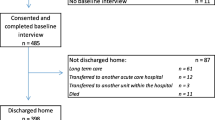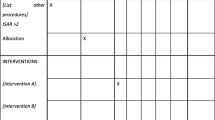Abstract
Background and aims: Elderly patients presenting to Emergency Departments (ED) have complex health problems and often undergo adverse outcomes after an ED visit. In Canadian ED, the Identification of Seniors At Risk (ISAR) is useful in screening for these aspects. This study evaluated the predictive validity of ISAR for elderly patients presenting to Italian ED. Methods: Prospective observational study of a cohort of 200 elderly patients presenting to two urban ED in Ancona (Italy). Identifiers and triage, clinical and social data were collected, and the ISAR was administered. The following single outcomes were considered: early (30-day) and late (6-month) ED revisit, frequent ED return, hospital admission, and functional decline. Composite outcomes were: [1] death, long-term care (LTC) placement, functional decline; [2] the same as [1] plus any ED revisit or hospitalization. Odds ratios (OR) and 95% confidence intervals (CI) were calculated. Results: ISAR was positive for 141 (70.5%) subjects, who had high comorbidity, disability and cognitive impairment. ISAR-positive atients hadan OR of 4.77(95% CI, 2.19–10.42) to undergo composite outcome [1] and of 3.46 (95% CI, 1.68–7.15) to experience composite outcome [2]. ISAR also predicted ED revisit and frequent use, hospitalization and functional decline at 6 months. ISAR was also an independent predictor of 6-month mortality (Hazard Ratio 6.9, 95%, CI 1.65–29, p=0.008). Conclusions: ISAR can be used as a screening test to identify Italian elderly ED patients who have an increased 6-month risk of death, LTC placement, functional decline, ED revisit, or hospitalization.
Similar content being viewed by others
References
Salvi F, Morichi V, Grilli A, Giorgi R, De Tommaso G, Dessì-Fulgheri P. The elderly in the emergency department: a critical review of problems and solutions. Intern Emerg Med 2007; 2: 292–301.
McCaig LF, Nawar EW. National Hospital Ambulatory Medical Care Survey: 2004 emergency department summary. Adv Data 2006; 372: 1–32.
Aminzadeh F, Dalziel WB. Older adults in the Emergency Department: a systematic review of pattern of use, adverse outcomes, and effectiveness of interventions. Ann Emerg Med 2002; 39: 238–47.
George G, Jell C, Todd BS. Effect of population ageing on emergency department speed and efficiency: a historical perspective from a district general hospital in the UK. Emerg Med J 2006; 23: 379–83.
Friedmann PD, Jin L, Karrison TG et al. Early revisit, hospitalization, or death among older persons discharged from the ED. Am J Emerg Med 2001; 19: 125–9.
McCusker J, Cardin S, Bellavance F, Belzile E. Return to the emergency department among elders: patterns and predictors. Acad Emerg Med 2000; 7: 249–59.
Caplan GA, Brown A, Croker WD, Doolan J. Risk of admission within 4 weeks of discharge of elderly patients from the emergency department — the DEED study. Age Ageing 1998; 27: 697–702.
McCusker J, Bellavance F, Cardin S, Belzile E, Verdon J. Prediction of hospital utilization among elderly patients during the 6 months after an emergency department visit. Ann Emerg Med 2000; 36: 438–45.
Mion LC, Palmer RM, Anetzberger GJ, Meldon SW. Establishing a case-finding and referral system for at-risk older individuals in the Emergency Department setting: the SIGNET model. J Am Geriatr Soc 2001; 49: 1379–86.
McCusker J, Bellavance F, Cardin S, Trepanier S, Verdon J, Ardman O. Detection of older people at increased risk of adverse health outcomes after an emergency visit: the ISAR screening tool. J Am Geriatr Soc 1999; 47: 1229–37.
Meldon SW, Mion L, Palmer RM et al. A brief risk-stratification tool to predict repeat emergency department visits and hospitalizations in older patients discharged from the emergency department. Acad Emerg Med 2003; 10: 224–32.
McCusker J, Jacobs P, Dendukuri N, Latimer E, Tousignant P, Verdon J. Cost-effectiveness of a brief 2-stage emergency department intervention for high risk elders: results of a quasirandomized controlled trial. Ann Emerg Med 2003; 41: 45–56.
Mion LC, Palmer RM, Meldon SW et al. Case finding and referral model for Emergency Department elders: a randomized clinical trial. Ann Emerg Med 2003; 41: 57–68.
McCusker J, Verdon J, Tousignant P, de Courval LP, Dendukuri N, Belzile E. Rapid emergency department intervention for elders reduces risk of functional decline: results of a multi-center randomized trial. J Am Geriatr Soc 2001; 49: 1272–81.
McCusker J, Dendukuri N, Tousignant P, Verdon J, Paulin de Courval L, Belzile E. Rapid two-stage emergency department intervention for seniors: impact on continuity of care. Acad Emerg Med 2003; 10: 233–43.
Fan J, Worster A, Fernandes CMB. Predictive validity of the Triage Risk Screening Tool for elderly patients in a Canadian emergency department. Am J Emerg Med 2006; 24: 540–4.
Moons P, De Ridder K, Geyskens K et al. Screening for risk of readmission of patients aged 65 years and above after the discharge from the emergency department: predictive value of four instruments. Eur J Emerg Med 2007; 14: 315–23.
Conferenza permanente per i rapporti tra lo stato, le regioni e le province autonome di Trento e Bolzano. Accordo 25 ottobre 2001. GURI n. 285 del 7 dicembre 2001. Available at: http://xoomer.alice.it/cabrach/Leggi%20nazionali/Linee%20guid ai%20triage%20e%20chirurgia%20mano.pdf
Charlson ME, Pompei P, Ales KL, MacKenzie CR. A new method of classifying prognostic comorbidity in longitudinal studies: development and validation. J Chronic Dis 1987; 40: 373–83.
Murray SB, Bates DW, Ngo L, Ufberg JW, Shapiro NI. Charlson Index is associated with one-year mortality in emergency department patients with suspected infection. Acad Emerg Med 2006; 13: 530–6.
Pfeiffer E. Short Portable Mental Status Questionnaire for the assessment of organic brain deficit in elderly patients. J Am Geriatr Soc 1975; 23: 433–41.
Katz S, Ford AB, Moskowitz RW, Jackson BA, Jaffe MW. Studies of illness in the aged. The index of ADL: a standardized measure of biological and psychosocial function. JAMA 1963; 185: 914–21.
Shinar D, Gross CR, Bronstein KS et al. Reliability of the activities of daily living scale and its use in telephone interview. Arch Phys Med Rehabil 1987; 68: 723–8.
Dendukuri N, McCusker J, Belzile E. The Identification of Seniors At Risk screening tool: further evidence of concurrent and predictive validity. J Am Geriatr Soc 2004; 52: 290–6.
Sistema Informativo Emergenza Sanitaria (SIES) del Lazio. Capitolo 1 — Analisi generali Dati SIES andamenti temporali 2000–2004. Attività SIES anno 2004. Available at: http://www.asplazio.it/asp_online/att_ospedaliera/sies_new/rapp_2004/volume/indice.php?menu=s22&emergenza=sies&sies=dat i. Accessed June 12, 2008
Li G, Lau JT, McCarthy ML, Schull MJ, Vermeulen M, Kelen GD. Emergency department utilization in the United States and Ontario, Canada. Acad Emerg Med 2007; 14: 582–4.
Warburton RN, Parke B, Church W, McCusker J. Identification of seniors at risk: process evaluation of a screening and referral program for patients aged > or =75 in a community hospital emergency department. Int J Health Care Qual Assur Inc Leadersh Health Serv 2004; 17: 339–48.
Hustey FM, Mion LC, Connor JT, Emerman CL, Campbell J, Palmer RM. A brief risk stratification tool to predict functional decline in older adults discharged from emergency departments. J Am Geriatr Soc 2007; 55: 1269–74.
Magid DJ, Masoudi FA, Vinson DR et al. Older Emergency Department patients with acute myocardial infarction receive lower quality of care than younger patients. Ann Emerg Med 2005; 46: 14–21.
McCusker J, Verdon J. Do geriatric interventions reduce emergency department visits? A systematic review. J Gerontol A Biol Sci Med Sci 2006; 61: 53–62.
Hwang U, Morrison SR. The geriatric emergency department. J Am Geriatr Soc 2007; 55: 1873–6.
Author information
Authors and Affiliations
Corresponding author
Rights and permissions
About this article
Cite this article
Salvi, F., Morichi, V., Grilli, A. et al. Predictive validity of the Identification of Seniors At Risk (ISAR) screening tool in elderly patients presenting to two Italian Emergency Departments. Aging Clin Exp Res 21, 69–75 (2009). https://doi.org/10.1007/BF03324901
Received:
Accepted:
Published:
Issue Date:
DOI: https://doi.org/10.1007/BF03324901




